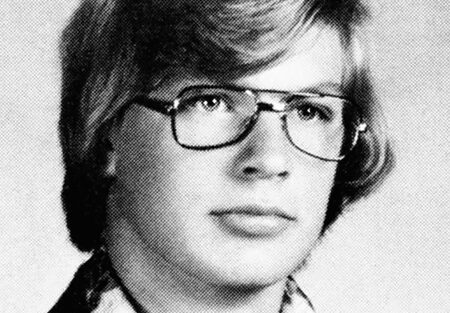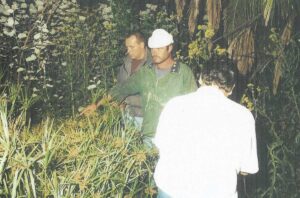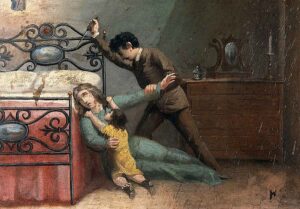Detectives can be commended for investigating and arresting serial killers, but in some cases, communities were being dismally failed by the system and innocent people were brutally killed. These deaths could have been prevented, had the killers not been considered too young!
The case of Jeffrey Dahmer poses a good example on how the system failed to prevent the murder of innocent victims. In 1989 when he was 28, Dahmer was charged with possession of pornography of children under the age of consent. During the court case one of the psychologists described him as suffering from a schizoid personality disorder and being extremely manipulative and it was recommended that he be institutionalized. Dahmer’s defence lawyer made the following statement during his plea: ” We don’t have a multiple offender here. I believe he was caught before the point where it would have gotten worse, which means that that is a blessing in disguise…” Unbeknown to the defence lawyer, by this time Dahmer had already killed five people. Dahmer was sentenced to a year’s imprisonment on the charge of possession of underaged pornography, but he was allowed to go to work every day.
In the five years he was on probation, his probation officer noticed something wrong, but did not investigate further because the suburb in which Dahmer had lived was deemed too dangerous to enter. On 26 May 1991, an underaged boy, Konerak Sinthasomphone, was found naked and drugged on the street, by two policemen. Dahmer came outside and convinced them that the child was his responsibility. The policemen escorted him back to Dahmer’s apartment and Konerak was murdered a few hours later. Did the defence lawyer, the parole officer and the police officers, who were all part of the system, fail through negligence or ignorance?
The following month Jeffrey Dahmer was finally apprehended. He had committed first murder in 1978, when he was 18 years old and continued killing for 13 years – despite being on probation for a sexual offence. He was sentenced to 16 life sentences (936 years) in 1992 and died in prison.
Another famous American serial killer, Ed Kemper, was sent to a correctional facility at the age of 15, for killing his grandparents. He was released in the custody of his mother. Thereafter he killed six young women, his own mother and her friend.
In 1984 in South Africa, Jan Abraham Christoffel Nel, or Chris, after having failed grade 9 and completing a year in the army, returned to his hometown Postmasburg in the North-West Cape Province, at the age of 18. He worked as a driver for the railways and lived in the railway’s hostel. Chris was a loner.
On the evening of 3 November 1984, Chris attended a disco at the local show grounds. He had several drinks during the day, but arrived at the disco in a sober state of mind. He asked a few girls to dance with him but most of them refused. To the 18-year-old Chris, this rebuff rekindled a rejection that he had experienced three months prior, when his girlfriend had dumped him for another man. It also reminded him of his mother, who had not only sent him to a hostel, but who seemed relieved when he informed her that he was going to run away to his grandmother, when he was 16.
Earlier that night at the disco a friend of Chris had given him his car keys and a small pocketknife was attached to these keys. At about eleven o’ clock that night when Chris went outside to relieve himself, he spotted two teenage girls entering the ladies’ toilets. At that moment he knew that he was going to kill them. He followed the girls inside.
Fifteen-year-old Rika Fouche was standing behind her friend, 17-year-old Miss S, combing their hair. In the mirror both girls saw the man with the knife in his raised hand. Miss S grabbed Rika and tried to drag her into one of cubicles, but Chris pulled her away. Miss S ran into the toilet cubicle and locked the door. She heard Chris tell Rika to take off her clothes and Rika refused. Miss S heard them struggling, then she heard Rika make a rasping noise and then everything was quiet. She climbed onto the toilet bowl and peeped over the wall, only to see Chris washing his hands. He turned around and smiled at her. Chris had slit Rika’s throat and had stabbed her about 25 times. She was lying in a pool of blood on the floor and he had ripped her panty with his knife, but did not manage to rape her.
Miss S tried to run away, but Chris managed to grab hold of her, picked her up and carried her out to the stables nearby. She pleaded with him not to kill her and he told her that he hated all women, and that his girlfriend had left him for another. Miss S answered that the girlfriend could not have loved him. This comment infuriated Chris who stripped Miss S and brutally raped her. As she bent down to pick up her clothes, she bumped into him and ran away naked. He followed and tackled her. As they fell, the lights of a vehicle shone upon them and Miss S managed to run towards the car. Chris ran away and hid in one of the stables, where he was discovered and taken to the Police Station.
At the Police Station he denied having anything to do with the incident, claiming that he merely saw the naked girl running from the stables and that he held on to her to comfort her. Meanwhile at the crime scene, Rika’s body and Chris’ friend’s knife was found. Chris was interrogated by Major Louis Swanepoel and confronted with the facts.
He admitted to killing Rika and he was pointed out by Miss S as the man who had raped her. He told Major Swanepoel that he hated women, and that he had no regret.
In June 1986, Mr Justice Basson decided not to pass the death sentence on Chris due to his youth and to the fact that he had no previous convictions. He sentenced him to an accumulative 20 years in prison for the murder and attempted rape of Rika Fouche and the rape of Miss S. The judge reprimanded Chris to utilise the time in prison to rehabilitate himself and not to bear a grudge against society.
For 12 years Chris sat in jail. He did not use these years to rehabilitate himself, but rather to brew and fester his hatred for women. Upon his parole release in January 1997 Chris settled in Upington, in the Northern Cape province, where he worked as a mechanic. Just up the street from his employment, the local sex workers plied their trade at night. Chris kept mainly to himself, lived in a garden flat and only went out with his colleagues. He had no other friends and did not date.
On the Friday evening of 10 November 1997, 18-year-old Hermien Maasdorp, a scholar, attended a dance at the Fantasy night club. At approximately one o’ clock she left the dance. Her friends, who saw her last, said she was looking for a lift home. Hermien’s body was discovered the following day in the deserted arid veld outside town. She was naked except for a bra. Hermien had been brutally attacked with a blunt object and she had been raped. She died due to head injuries. Swabs were taken and the Forensic Science Laboratory managed to isolate a DNA profile.
Two months later, during December 1997, 22-year-old Belinda Visagie, a sex worker, was plying her trade when Chris picked her up. According to the sex workers, Chris was a regular client of theirs, but he called himself Johan. Chris drove out to a remote spot in the semi-desert, where he had consenting sex with Belinda.
He then demanded anal sex, which she refused. Chris lost his temper and began assaulting Belinda. He also struck her with a bottle in her face and on her head. Chris threatened to kill Belinda, but she managed to run away. When he could not find her, Chris left. Belinda crawled to the road and managed to get a lift home with another woman. She did not report the assault to the police, but she was examined by a doctor who confirmed her multiple injuries.
About three months later on 18 March 1998, Chris accompanied his colleagues to a pub. Sometime during the night he became separated from his colleagues and drove the company truck to Roux Street, where he picked up 30-year-old Janetta Meintjies, a sex worker. Belinda and the others warned Janetta not to go with Chris since he had assaulted Belinda. Janetta answered that she had a date with the man.
The following day Janetta’s body was discovered in the veld, about 400 metres from the spot where Belinda had been assaulted. She was naked and her face was covered with sand. Janetta had multiple injuries to her body and face. The impact of a blow had broken off her jaw and lodged it in her throat, which caused her to suffocate. Janetta’s body was identified and the sex workers told Sergeant Jacques Visser, the investigating officer, that she had been picked up by Chris in his company truck. Chris was arrested on 23 March 1998 at his place of work. Visser knew about the unsolved murder of Hermien Maasdorp and requested blood samples of Chris. His DNA matched the DNA identified in Hermien’s murder. In the meantime the other sex workers convinced Belinda to lay an assault charge against Chris.
During July 1999 Chris was charged with attempted murder on Belinda Visagie, the murder and rape of Hermien Maasdorp and the rape and murder of Janetta Meintjies.
Advocate Johan de Nysschen represented the State and advocate George Galloway represented the accused in Upington, before the honourable Mr Justice Kriek.
Chris pleaded not guilty to all the charges. I testified in this case and Chris did not contest my testimony. On 28 July 1999 Chris was found guilty on all the charges except on the rape of Janetta. Since she was a sex worker it could not be proved that she did not consent to sex. Chris was sentenced to life imprisonment. What will happen if he is ever let out on parole again? It had taken him scarcely 11 months to kill again when he was released on parole the first time.
Hermien’s father cried softly in the public gallery when Judge Kriek pronounced Chris guilty of his daughter’s murder and rape.
In another South African case, in May 1971, 20-year-old William van der Merwe was found guilty of two attempted assaults and one attempted rape and given a suspended sentence due to his young age. Scarcely a few months later, between September and November 1971, William van der Merwe the “Screwdriver Rapist” raped at least nine women including a 14-year-old schoolgirl after gagging her and threatening her with a screwdriver, hence his moniker.
Van der Merwe was sent to Sterkfontein Psychiatric hospital for 28 days’ observation and pronounced fit to stand trial. Mr Justice JH Steyn, who presided over the trial, said, “This is one of the grimmest cases of rape I’ve known in 15 years on the Bench. A young and very attractive girl – a virgin until she was ravaged by van der Merwe . . . This is the kind of person I’m going to protect.” On 22 March 1972 Van der Merwe was given the death sentence, which was subsequently commuted to 20 years in prison by the Appeal Court.
During his 15 years in prison, Van der Merwe attended a rehabilitation programme in the psychiatric ward of the Zonderwater prison. Due to good behaviour, when his parole hearing came up in 1987, he was found cured and released.
Two years later two young women were hitchhiking at Muizenberg beach where Van der Merwe picked them up. Unbeknown to them he had three sets of handcuffs and 29 screwdrivers in a toolbox in the back of his truck. Van der Merwe drove to a deserted part of Constantia forest where he raped one of the girls. Afterwards he offered both girls cigarettes and promised not to harm them. Then he drove them to the Grabouw forest about 60 km outside Cape Town. He got undressed, raped the second girl in front of her friend and forced her to walk with him into the forest, but not before he cuffed the other girl’s hands behind her back and tied her feet together. She managed to get hold of his discarded pants and found his firearm.
He returned alone with a knife in his hand. She aimed and shot him in the head and then in the shoulder. She cut the rope binding her feet and managed to make her way to the road where a motorist picked her up and took her to the police station.
When the police returned to the scene they found the other girl stabbed to death. Van der Merwe was still alive, but died a few hours later in hospital without regaining consciousness.
In these cases leniency was given to the killers, Dahmer, Kemper, Van der Merwe and Nel, due to their young age – but despite being given life sentences, after being released, within a few months, they killed again, more brutally than before.
In South Africa a life sentence is 25 years. Parole can be granted halfway and if the criminal is well-behaved he can get his sentence reduced by a third. To bypass this anomaly judges often pronounce two sentences – for example, for rape and for murder — that do not run concurrently.
The high-profile trial of Screwdriver van der Merwe prompted amendments to the Criminal Procedure Act in 1993 following recommendations by the Booysen Commission of Inquiry. Sections 286 A and 286 B state that if the court is satisfied the person represents a danger to the physical or mental wellbeing of others and if the community should be protected against him or her, the court must declare the individual a dangerous criminal.
In 1998, Justice Chris Jansen sentenced Stewart Wilken, South Africa’s cannibal serial killer, to seven life sentences and the Judge added that he would have given the death penalty had it still been available to him. Clearly the judge had no intention to see Wilken leave the prison. Yet Stewart Wilken is up for parole – is he not considered a dangerous criminal against whom the community should be protected?
Top image: Jeffrey Dahmer, pictured in the 1978 Revere High School yearbook, Reverie (Public Domain)







